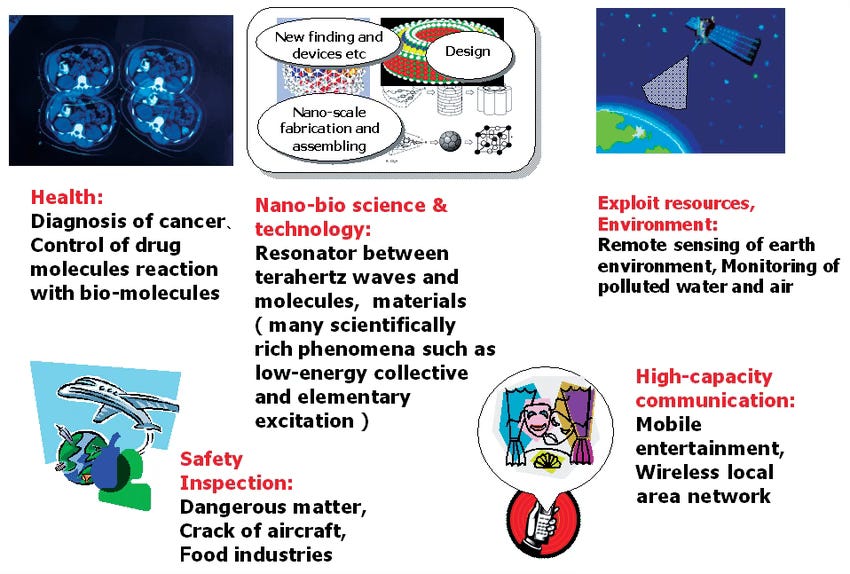IR Waves aren't good. You know what's good? Terahertz waves are GOOD.
Apologies to Aaron Sorkin for that headline.
In the vast spectrum of electromagnetic waves, we go from light waves (X-rays, infrared, etc.) to radio waves, and we primarily do this by their frequency (wave cycles per second.) However, an intriguing frontier exists between these two realms: the "terahertz gap," home to the elusive and powerful terahertz waves. Situated between the highest-frequency radio waves and the lowest-frequency infrared light, this region holds immense promise.
Terahertz waves offer a unique combination of properties: the penetrating capabilities of radio waves and the precision of optical technologies. This makes them exceptionally versatile. Their potential applications are vast and transformative, including:
Pharmaceutical Quality Control: Terahertz imaging can non-destructively identify impurities, detect variations in crystalline structures, and ensure the consistency and quality of pharmaceutical products.
Semiconductor Inspection: These waves can probe the internal structures of semiconductors, detecting defects and ensuring the integrity of microchips, crucial for advancing electronics.
Food and Water Safety: Terahertz spectroscopy can detect contaminants, pathogens, and moisture levels in food and water, enhancing safety and quality control.
Security and Surveillance: Terahertz imaging can penetrate clothing and non-metallic materials, enabling advanced security screening for concealed weapons or explosives, without the ionizing radiation of X-rays.
Medical Diagnostics: Terahertz waves can differentiate between healthy and cancerous tissues, offering potential for non-invasive cancer detection and diagnosis. They can also be used for skin hydration measurements, and other medical imaging.
Materials Science and Non-Destructive Testing: Terahertz technology can analyze the composition and structure of materials, including composites, polymers, and ceramics, without causing damage. This is valuable for quality control in manufacturing and for assessing the integrity of infrastructure.
Cultural Heritage Preservation: As you mentioned, terahertz imaging can reveal hidden layers in paintings, manuscripts, and other artifacts, aiding in restoration and authentication. It can also be used to analyse the composition of the materials used in the artifacts, aiding in the preservation process.
Environmental Monitoring: Terahertz spectroscopy can detect and measure atmospheric pollutants, contributing to environmental monitoring and climate research.
High-Speed Wireless Communication: Terahertz frequencies offer the potential for extremely high-bandwidth wireless communication, enabling faster data transfer and supporting future applications like 6G and beyond.
Astronomy: Terahertz observations can penetrate interstellar dust clouds, revealing the formation of stars and galaxies, and providing insights into the early universe.

This incredible potential has made terahertz research a "holy grail" in electromagnetics. However, significant challenges have hindered its widespread adoption:
Fabrication Complexity: The extremely high frequencies of terahertz waves, in the trillions of cycles per second, push traditional circuit theory to its limits. Wavelengths approaching the size of circuit components create formidable engineering and economic hurdles in terms of geometry, materials, and precision.
Dielectric Mismatch: The transition of terahertz waves from silicon (high dielectric constant) to air (low dielectric constant) results in significant reflection, hindering efficient transmission.
MIT's recent breakthrough offers an elegant solution. By engineering a perforated sheet that acts as an electromagnetic mediator between silicon and air, and integrating it with Intel's advanced transistor architecture, they have achieved unprecedented efficiency in terahertz wave generation. This innovation addresses both challenges: it provides a manufacturing-compatible solution and creates a gradual transition between silicon and air.
The practicality of this solution, with its compatibility with existing manufacturing processes and a projected implementation timeline (potentially by 2027), underscores the rapid progress in semiconductor technology and the growing industrial interest in terahertz applications.
What we have here is overcoming seemingly insurmountable barriers through innovation and experimentation. It’s an age-old story. We unlock new frontiers, we solve enigmas like the terahertz domain and we move on. We advance human knowledge and capabilities.
Advancing human knowledge and capabilities? That’s good.





